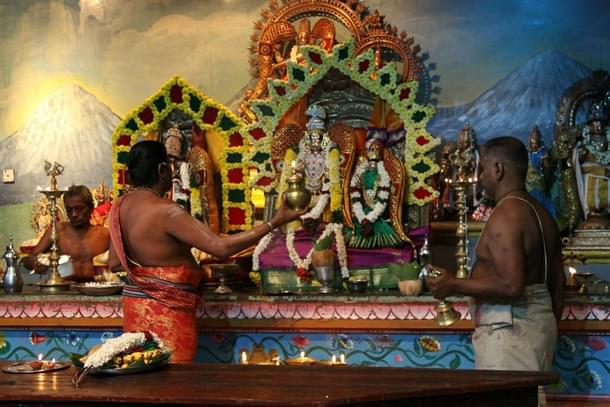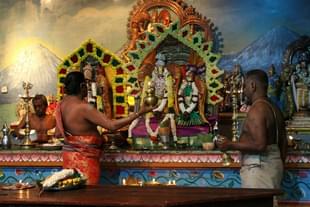Ideas
Indian Purohit-Archaka Service (I.P-A.S): An Idea Whose Time Has Come?
Aravindan Neelakandan
Mar 16, 2024, 06:00 AM | Updated Mar 15, 2024, 07:02 PM IST
Save & read from anywhere!
Bookmark stories for easy access on any device or the Swarajya app.


In his seminal work, The Annihilation of Caste, which in itself is an eloquent expansion of a lecture to be delivered to the Jat-Pat-Todak Mandal, Dr B R Ambedkar presented a proposal of profound significance.
Regrettably, this proposal remains overlooked even by those who hold Dr Ambedkar in the highest esteem.
The proposal is located within a five-point scheme he put forth for the removal of casteism in Hindu society. These five points were:
1. There should be one and only one standard book of Hindu religion, acceptable to all Hindus and recognised by all Hindus. This of course means that all other books of Hindu religion such as Vedas, Shastras, and Puranas, which are treated as sacred and authoritative, must by law cease to be so, and the preaching of any doctrine, religious or social, contained in these books should be penalised.
2. It would be better if priesthood among Hindus were abolished. But as this seems to be impossible, the priesthood must at least cease to be hereditary. Every person who professes to be a Hindu must be eligible for being a priest. It should be provided by law that no Hindu shall be entitled to be a priest unless he has passed an examination prescribed by the state, and holds a sanad from the state permitting him to practise.
3. No ceremony performed by a priest who does not hold a sanad shall be deemed to be valid in law, and it should be made penal [punishable] for a person who has no sanad to officiate as a priest.
4. A priest should be the servant of the state, and should be subject to the disciplinary action of the state in the matter of his morals, beliefs, and worship, in addition to his being subject along with other citizens to the ordinary law of the land.
5. The number of priests should be limited by law according to the requirements of the state, as is done in the case of the India Civil Services (ICS).
One might set aside the profound and entirely warranted indignation that Dr Ambedkar’s discourse harboured towards Hinduism. It is also possible to overlook the antiquated belief that Hinduism ought to be unified under a singular canonical text, relegating all others to obsolescence, with legal penalties for teaching their doctrines.
Such perspectives, however, are comprehensible within their historical context.
Dr Ambedkar’s era was marred by the misuse of Hindu scriptures to endorse and enforce birth-based societal segregation. Self-proclaimed adherents of Sanatana Dharma lobbied the British authorities to institutionalise caste distinctions and perpetuate practices of untouchability and unapproachability, citing religious texts as justification.
Nevertheless, it becomes a moral imperative to delineate the essence of what is truly eternal (‘Sanatan’) in the practice of Sanatana Dharma.
The question is: does it align with the interpretation of figures like the Puri Shankaracharya, or does it resonate more with the teachings of luminaries such as Swami Vivekananda, Sri Aurobindo, Sri Narayana Guru and Mahatma Gandhi?
It is incumbent upon those who identify as Hindu dharmacharyas, and the Sangh Parivar organisations capable of convening these religious leaders, to articulate a definitive stance on this matter.
The swifter this clarification is achieved, the more rapidly can Hindu society collectively and decisively eradicate, both ideologically and politically, the forces that exploit the vagueness of the term ‘Sanatana Dharma’ to propagate animosity.
Meanwhile, when a Tamil Nadu Bharatiya Janata Party (BJP) leader makes a statement that the first official signature to be made when the BJP comes to power in Tamil Nadu, would be for sending the state out of the temples, and entrusting their stewardship to the community, a palpable disquiet resonates.
The fact that the Hindu Religious and Charitable Endowments Department (HR&CE), the custodian of temple administration, is mired in inefficiency, and corruption allegations is incontrovertible. Accusations abound, indicting the department of flouting regulations and desecrating the architectural and spiritual heritage of these sacrosanct sites.
A cohort of devout activists, albeit modest in number, has been galvanised into action, championing the cause to liberate these temples from the HR&CE. Yet, this fervour for emancipation seems not to have permeated the collective consciousness of Tamil Hindus, who appear indifferent towards the effort.
One wonders whether this apparent indifference masks a deeper apprehension. Could there be an underlying fear that the ousting of HR&CE might resurrect bygone caste prejudices, igniting conflicts over trusteeship, governance, and even access to these hallowed spaces?
Is there a feeling that such upheaval could unravel the threads of Hindu communal harmony that were painstakingly woven through the challenges of colonial interventions and social stagnation, and regress social cohesion to a bygone era?
These questions loom large, casting long shadows over the future of temple governance.
However, they could potentially be resolved using the solutions outlined in Dr Ambedkar's five-point formula from his 1936 work.
The initial concept of a single book could be solidified into firm, inviolable principles, echoing the ideas of 'liberty, fraternity, and equality' (as emphasised elsewhere in the same book, with a suggestion that these principles could be derived from the Upanishads).
Diversity of Hinduism need not be bound by a single tome but can be instead united by the sacred, unassailable principles that celebrate the divine in every form of life. This unity would uphold the dignity of all existence, reflecting the essence of Dharma and the profound declarations of the Upanishadic Mahavakyas.
At the heart of this vision lies the critical need to evolve beyond the anachronistic hereditary priesthood.
In today’s world, such a system is more a quaint artefact than a living tradition, akin to a treasured yet obsolete relic in a museum rather than a thriving, dynamic force in our places of worship. It’s time to embrace a future that befits our sacred spaces with relevance and vitality.
Here is a blueprint submitted with all humility at the sacred feet of all the Dharmacharyas of all the sampradayas to consider.
Like for the present ICS, a comprehensive foundational curriculum should be established for priests. This curriculum would encompass the essential sciences, ranging from the intricacies of organic evolution to the vastness of modern cosmology with their philosophical and spiritual implications for Indian schools like Vedanta.
There should also be the core social sciences, bridging Western ideologies with the profound insights of Hindu Darshanas.
This should also integrate itself with psychological and ecological sciences, addressing the contemporary challenges faced by individuals and society.
Additionally, a specialised segment focusing on Hindu-centric historical perspectives could be included. Collectively, these elements would constitute the secular facets of the Indian Purohit-Archaka Services (I.P-A.S), fostering a well-rounded and culturally attuned administrative cadre.
All these should be learnt by a seeker who wants to serve a Hindu deity in a Hindu temple.
Aspirants to the I.P-A.S must undergo courses that confer fluency in regional languages, with an emphasis on Bhakti literature and a scholarly grasp of Sanskrit aligned with Vedic Studies.
This requirement steers the I.A-P.S towards a more regional rootedness compared to the conventional IAS and IPS paths. Candidates are expected to partake in rigorous, tradition-specific training that resonates with their selected sampradaya.
Leaders of each sampradaya bear the critical responsibility of crafting curricula that not only attract but also resonate with those eager to dedicate themselves to the I.P-A.S, honouring their unique traditions. Educational content should bridge the gaps between various sampradayas, fostering a spirit of unity and mutual respect while eschewing any form of belittlement.
This endeavour seeks to infuse new life into the priesthood, creating a vibrant and distinguished assembly of priests that reflect the rich tapestry of India’s social fabric. While Brahmins will definitely find themselves at an initial advantage, the vision is for a progressive levelling of the playing field, thereby elevating the prestige and impact of the Hindu priesthood across the nation.
They are Dharmic civil servants entitled to a central government pay. They are 'priestocrats' who shall command respect similar to any civil servant throughout India.
In temples where the atmosphere whispers ancient wisdom, there stand priests, not merely as guardians of traditions but visionaries for Hindu society. These 'priestocrats', with their profound understanding of both doctrine and societal pulse, are destined to forge an emotional unity across India.
In this context where faith and governance meet, the specific identities of trustees become less important, as the temple operates with a sense of spiritual democracy.
In India, only the BJP's ideology is seen to resonate with this vision inspired by Dr Ambedkar.





